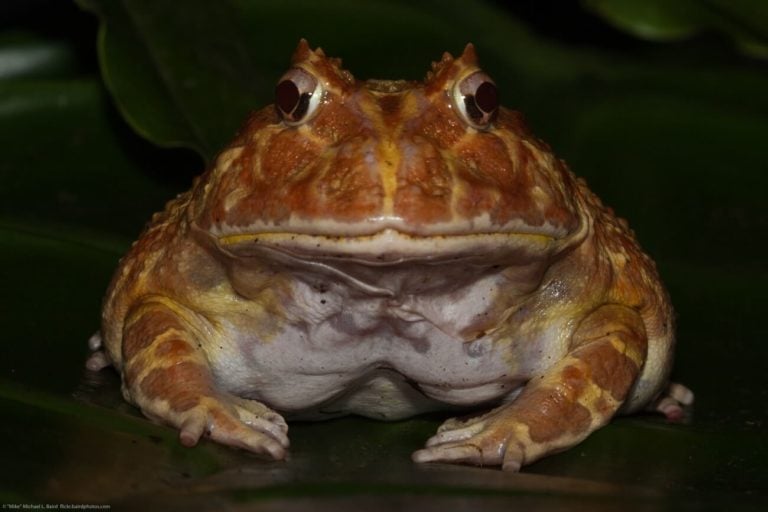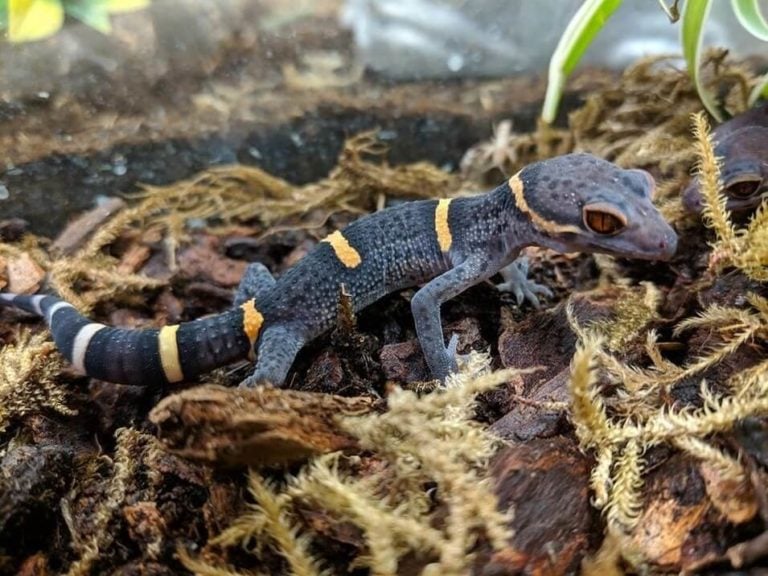Woma Pythons are a fantastic (and beautiful) pet reptile that we recommend to beginners quite often. These snakes have a mellow temperament, look great, and are very easy to care for.
But it’s still very important to understand their fundamental needs if you’re considering purchasing one. The more you know, the more your snake will thrive.
In this guide, we’ll cover the essentials of Woma Python care (plus a few interesting facts). By the time you’re done reading this, you’ll be completely ready for ownership!
Table of Contents
Species Summary
The Woma Python (Aspidites ramsayi) is a beautiful species with a personality you don’t usually see with other pythons.
It’s more active than other popular python species. However, it’s also mild-mannered and highly predictable!
Thanks to its docile nature, the Woma is one of the easier snakes to handle. This makes it great for beginners.
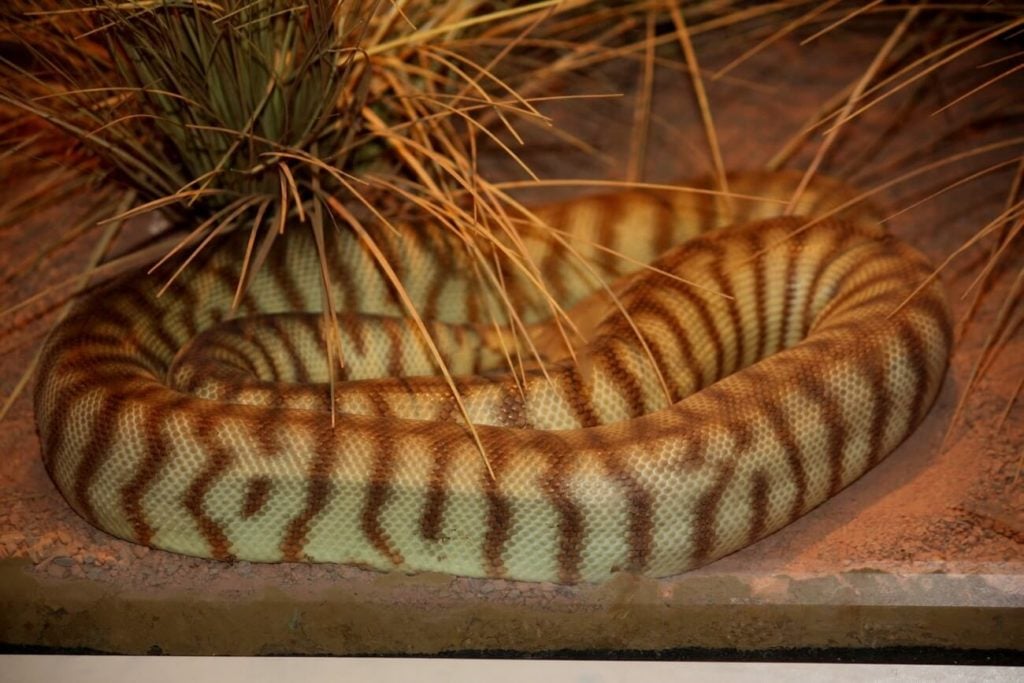
With that being said, its beauty and graceful movement make it a popular choice even for seasoned snake owners.
The Woma is native to Central and Southwestern Australia, but is considered endangered in certain regions. It prefers dry arid regions of the country and spends most of its time buried under the ground.
In captivity, the Woma Python is an unfussy snake that’s a joy to care for. If you’re looking for a low-maintenance species to build a bond with, this is one of the best pet snakes for you.
Woma Python Size
Typically, the max size of a healthy adult Woma Python can be up to six feet in length. On the lower end of the spectrum, some specimens may only make it to four and a half feet.
Expert Tip: Woma Pythons larger than six feet have been recorded. There are reports of this species getting up to eight feet long, but those instances are very rare.
Lifespan
Woma Pythons have a lifespan of 20 years or more! That means if you want to care for these snakes you need to be ready for a long-term commitment.
Of course, helping your snake reach that ripe old age will require vigilant care. Like all snakes and reptiles, the Woma can experience health issues that could shorten their life expectancy. Poor husbandry will make it more susceptible to stress and disease, so you must stay on top of their care at all times!
Appearance & Colors
The Woma Python has an appearance that reflects its natural habitat. Usually, you can find these snakes in red sand deserts. Their coloration is meant to camouflage them in the sand.
The base color of the snake can be light gray, silver, or a creamy beige. On top of that, you’ll find thick bands of light or dark brown. The intensity of those bands varies from snake to snake. For some, they are faint and difficult to distinguish.
Expert Tip: Others have a more distinct separation between the colors. Some snakes even have broken bands to create a mottled look.
The head of the snake usually features a more vibrant yellow color. You might also see some darker shades of brown around the small eyes.
The body of the Woma Python is broad and somewhat flat. It’s covered in smooth scales and has a thin pointed tail.
The scales of this snake are very smooth. They’re also pretty small. That is, however, with the exception of the head. The head of the snake has large plated scales that look noticeably different than those on the rest of the body.
Woma Python Care
While Woma Python care is actually fairly easy, that doesn’t mean you should take their husbandry needs lightly. These snakes require an environment that’s consistently maintained and monitored in order to stay healthy.
Follow these guidelines to keep your snake in good shape for years to come!
Enclosure Size
Womas don’t need a massive enclosure, but it’s still a good idea to provide ample space. For the most part, using a standard 40-gallon terrarium with a mesh top should work fine.
Expert Tip: When it comes to enclosure size, dimensions are important too. At the very least, the enclosure should measure about 36 inches long, 18 inches wide, and about 16 inches tall.
If you can go with a slightly bigger enclosure it’s never a bad thing. Remember, these snakes are active, so having a bit of extra room is always good!
Habitat Setup
The Woma Python isn’t too demanding when it comes to decor (this is another reason why they’re so easy to care for). In the wild, they usually bury themselves in the sand or find a cozy spot to hide during the day.
For the substrate, you have a couple of different choices.
You can use a sanitized light sand if you want to mimic their natural environment. Aspen mulch works well, too. Alternatively, you can use low-maintenance beddings like reptile carpet or newspaper.
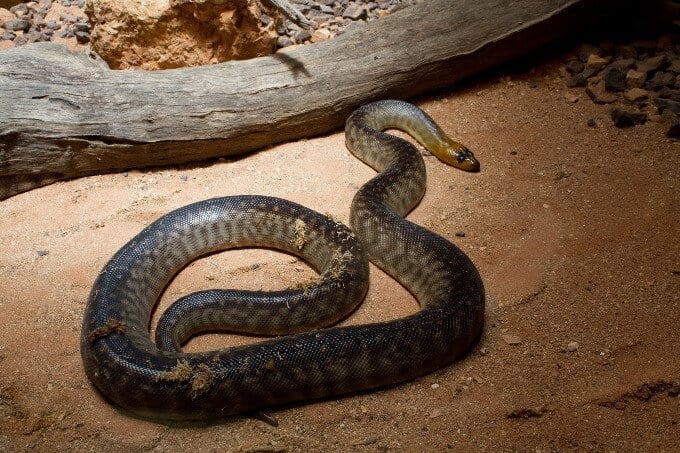
Beyond the substrate, the only thing the snake needs is a hide box. Molded caves or wooden boxes work well. Choose a box that’s large enough to fit the entire snake. But, don’t get something that’s too big.
These snakes like to be in tight recesses, so a snug hide box is best. You might need to increase the size of the box as they grow though!
You can always add some other decorations in the enclosure to give your Woma Python some enrichment. Flat rocks for climbing and lounging are appreciated but not a requirement for this species.
Temperature & Lighting
Recreating that hot Australian air is a must! You can do this with either an under-tank heater, a heat emitter, or standard halogen lights.
In most cases, halogen lights are going to be the best choice. Ideal ambient daytime temperatures should be between 75 and 85 degrees Fahrenheit.
On one side of the enclosure, you need to create a basking spot that’s around 90 degrees. Woma Pythons self-regulate their heat, so creating a temperature gradient in the closure will allow them to get comfortable by moving around.
At night, daytime temperatures can get as low as 72 degrees. If your home gets colder than that, you’ll need to use a heat emitter or radiant heat system (get a reliable thermometer to check this).
Woma Pythons are nocturnal, so you must keep the lights off once the Sun goes down.
Expert Tip: To view your Woma at night, you should use a red-spectrum light. But even then, keep this off unless you’re actively watching your python.
Humidity
Humidity levels around 50 to 70 percent are what you should aim for.
It’s important to use an accurate hygrometer to ensure that levels don’t go beyond this range. Health issues can occur when the snake is getting too much or not enough humidity.
To raise the level of humidity in their habitat, mist the enclosure once a day. You might also want to consider using an absorbent substrate, such as aspen mulch. Adding some damp moss to the habitat works very well too.
Water
Woma Pythons get most of their hydration through moisture in the air. However, it’s still a good idea to keep a shallow bowl of water in their habitat.
This water bowl will help keep humidity levels stable. Your snake may also use it to soak their skin every once in a while! Because of this, it’s important to get a sturdy tip-proof bowl.
Expert Tip: Keep it filled with fresh water and clean it frequently. Snakes often defecate in water bowls, so you’ll need to wash it regularly to avoid bacterial issues.
Food & Diet
Woma Pythons can eat a lot of different foods. In their natural habitat, these snakes usually eat small lizards and other reptiles.
Their diet in captivity should consist of mainly mice, chicks, and ducklings. You can provide the occasional reptile snack as well, but that should never be a large part of their diet.
These pythons are fine with either frozen or live foods. As a good rule of thumb, the food item should be no bigger than the space between their eyes.
You can feed the snake every 10 to 14 days. Make sure that you don’t overfeed your Woma Python! The species can easily gain weight in captivity.
Expert Tip: Womas have an interesting way of feeding that can take new owners by surprise. Oftentimes, they’ll constrict their prey by pressing it against the side of the enclosure wall or hide box. This technique is used because the snakes usually take their prey into their burrows in the wild.
Potential Health Issues
No snake is immune to health issues, and the most common problem you’re going to have to deal with relates to humidity.
Woma Pythons are very sensitive to excess moisture in the air. If the humidity levels are too high, they can experience respiratory infections and skin blisters.
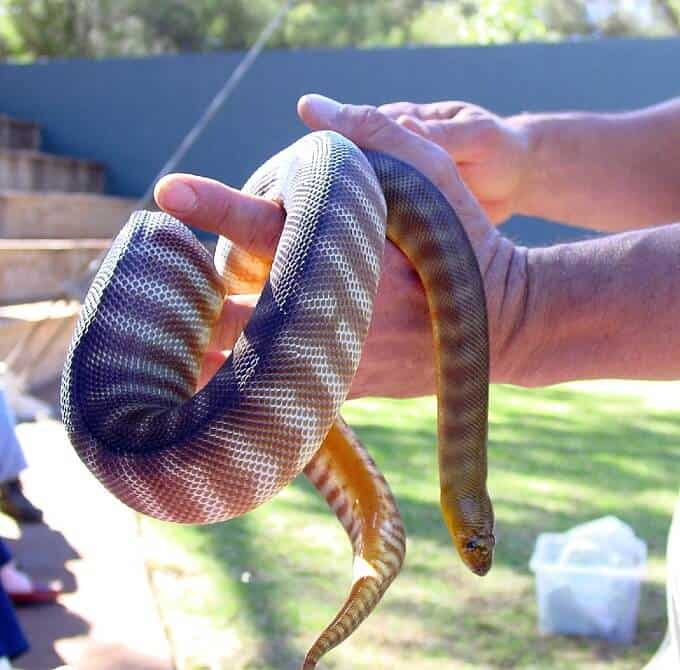
Respiratory infections are an internal problem that will affect the soft tissue in their mouth and nostrils. This may require veterinary intervention in some cases, so keep an eye out for any discharge.
Skin blisters are equally worrisome, as they can lead to bacterial infections.
Bacteria can flourish in your snake’s enclosure. There’s no way to eliminate it completely, but you should do your part to ensure that bacterial colonies get out of hand.
Every month, clean the enclosure out thoroughly. Use a reptile-safe sanitizer to wipe down every corner of the enclosure. This will keep bacterial issues under control. Also, do some spot cleaning throughout the week.
Temperament & Behavior
As mentioned earlier, Woma Pythons are docile creatures with a mellow temperament. They’re not flighty or unpredictable like some other species.
Younger Pythons may be a bit more skittish and bite handlers every once in a while. However, these snakes grow out of that pretty quickly.
The longer you continue to care for the snake, the more trusting it will become. Of course, you should still practice safety measures. However, you don’t have to go to extremes like creating separate feeding tanks.
Woma Pythons are nocturnal creatures, so they will remain in hiding most of the day. Once the sun goes down, they will move around the environment. If you have loose substrate, you might even see them burring their heads or bodies to get cozy!
Handling Them
Woma Pythons don’t mind being handled. You may encounter some resistance in the beginning, but this is normal since the snake is still building some trust.
In general, most Womas will get comfortable with owners pretty quickly.
When you lift them, support their body at the thickest point. Be gentle and move slowly to avoid stressing the snake out. Once you have them in your hand, they will likely wrap around your arm to get comfortable.
Expert Tip: You can usually handle these snakes regularly without any issues. However, we do recommend holding off on handling a few hours before feedings. You should also give the snake time to digest their food afterward to avoid regurgitation.
Conclusion
Woma Python care is something that anyone can manage. All you need to do is stick with the recommendations in this guide and be consistent!
These snakes are a great choice for just about anyone. They’re low-maintenance, gorgeous, personable, and fun to observe.
We hope you learned a lot about the Woma Python, and are always available if you have any other questions.

